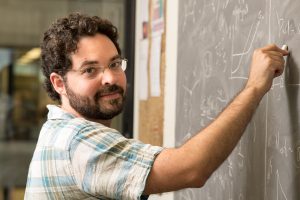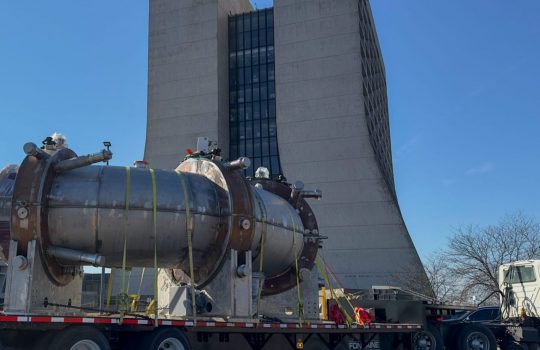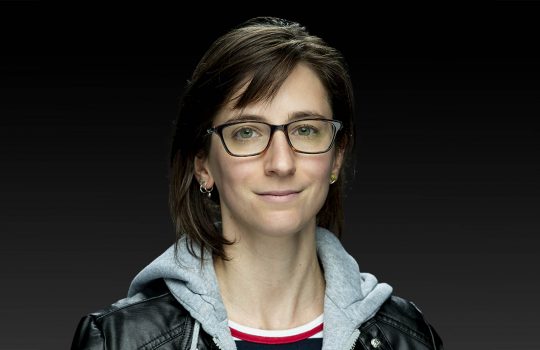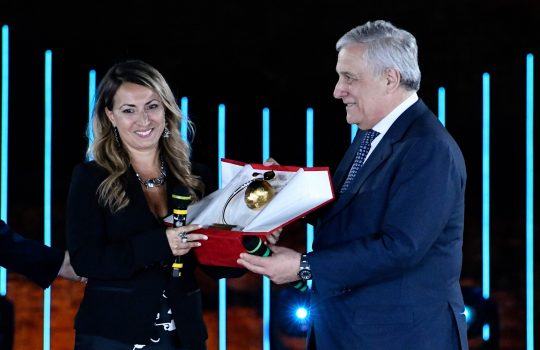
Fermilab scientist Pedro Machado recently received a DOE Early Career Research Award to develop theories on neutrino physics. Photo: Reidar Hahn
Fermilab is a world leader in neutrino science, and as a host for experiments such as DUNE, the Deep Underground Neutrino Experiment, it is poised to explore new physics for decades. Fermilab scientist Pedro Machado is working to create new ideas and theories to ensure that Fermilab gets the most out of its cutting-edge technology and research efforts.
“What I really hope to accomplish with the project is to be sure that we extract as much information as possible from our neutrino experiments here at Fermilab — to be sure that we don’t leave a stone unturned,” Machado said. “The main idea is to try to get hardcore theory ideas and connect them to the experimental data and how it is analyzed.”
Machado has received the prestigious Department of Energy Early Career Research Award to pursue this work. It will provide Machado $2.5 million for five years so he can develop new theories and methods to interpret the results of the Fermilab neutrino experiments.
The funds will allow Machado to hire postdoctoral researchers and to invite outside experts to assist Fermilab with particularly specialized questions on neutrinos. He will also use the award money to organize conferences on neutrino theories to generate new ideas and get scientists from other institutions involved in the efforts.
“I’m sure that I could not have gotten the award without the amazing colleagues I have here at Fermilab,” Machado said. “Specifically, the Theoretical Physics Department is inspiring and supportive, and it’s a unique enriching experience to be able to work directly with experimentalists. I think a big reason I got the award is that most of the theoretical neutrino work needs to be done in collaboration with experimentalists; you cannot just sit in your office and accomplish the same. There aren’t many places in the world I could do that. Fermilab is unique in how it approaches groundbreaking research that can have an impact in neutrino science.”
In general, researchers cannot possibly record and analyze all of the data that a neutrino experiment can generate, so theorists, like Machado, help experimentalists make decisions about what data to observe, what to look for in that data and how to interpret what they find.
Fermilab is a fertile environment for collaborations between the two types of physicists. Machado has been a theorist at Fermilab since 2016, and neutrinos have held his attention since then.
“When I got here, I was fascinated by the possibility to work on neutrino science, because there are many exciting ideas being challenged by the lab’s experiments,” Machado said. “So I essentially started dedicating 99% of my research into topics related to the most intriguing neutrino questions.”
As a member of the Fermilab Theoretical Physics Department, Machado and his colleagues plan to explore theoretical ideas that aim to answer major physics questions using the data generated at Fermilab experiments — questions such as “Where do neutrino masses come from?”, “Are neutrino key players in the matter-antimatter imbalance observed in our universe?” and “How are neutrinos related to dark matter?”
“Machado will lead the efforts in neutrino science at the Fermilab Theoretical Physics Department in the next decades,” said Marcela Carena, head of the Fermilab Theoretical Physics Department. “He is a brilliant scientist and has unique leadership capabilities. The award is a testimony of his scientific excellence, and we feel honored to have him in our team.”
Machado also plans to tackle the question of whether sterile neutrinos exist. Sterile neutrinos are a fourth type of neutrino that is theorized to exist and would be even harder to detect than the other known neutrinos, which are famous for being elusive.
Directly observing sterile neutrinos isn’t an option. Unlike other neutrinos, a sterile neutrino would interact with other particles exclusively through the gravitational force — a force that acts on mass alone — and neutrino masses are imperceptibly tiny. To hunt for sterile neutrinos, researchers have to look for something else — apparent discrepancies in how observable neutrinos morph between the three known types. Those discrepancies can point to the presence of a sterile neutrino.
Fermilab’s Short-Baseline Neutrino Program, with its three neutrino detectors, is designed for detailed investigations into the way neutrinos change from one type to another, and the program’s experiments will require the guidance of detailed theories to tease out the possible subtle influence of sterile neutrinos.
“I am very happy to receive this grant,” Machado said. “It will boost the work that we are doing here.”
This work is supported by the Department of Energy Office of Science.



